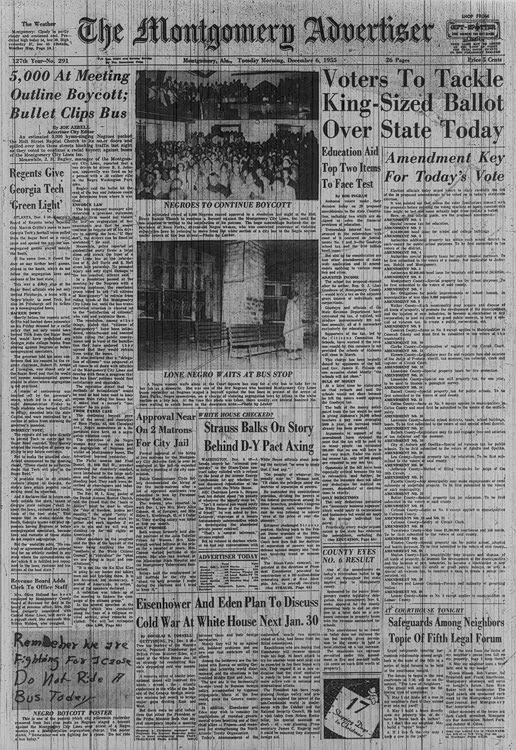Civil Rights Struggle in Modern TimesThe Civil Rights Movement was at a peak from 1955-1965. Congress passed the Civil Rights Act of 1964 and the Voting Rights Act of 1965, guaranteeing basic civil rights for all Americans, regardless of race, after nearly a decade of nonviolent protests and marches, ranging from the 1955-1956 Montgomery bus boycott to the student-led sit-ins of the 1960s to the huge March on Washington in 1963.1954 -- U.S. Supreme Court declares school segregation unconstitutional in Brown v. Board of Education of Topeka ruling. 1955 -- Rosa Parks refuses to move to the back of a Montgomery, Alabama, bus as required by city ordinance; boycott follows and bus segregation ordinance is declared unconstitutional. 
Federal Interstate Commerce Commission bans segregation on interstate trains and buses. 1957 -- Arkansas Gov. Orval Rubus uses National Guard to block nine black students from attending a Little Rock High School; following a court order, President Eisenhower sends in federal troops to ensure compliance. 1962 -- President Kennedy sends federal troops to the University of Mississippi to quell riots so that James Meredith, the school's first black student, can attend. |
The Civil Rights EraThe post-war era marked a period of unprecedented energy against the second class citizenship accorded to African Americans in many parts of the nation. Resistance to racial segregation and discrimination with strategies such as civil disobedience, nonviolent resistance, marches, protests, boycotts, "freedom rides," and rallies received national attention as newspaper, radio, and television reporters and cameramen documented the struggle to end racial inequality. There were also continuing efforts to legally challenge segregation through the courts.Success crowned these efforts: the Brown decision in 1954, the Civil Rights Act of 1964, and the Voting Rights Act in 1965 helped bring about the demise of the entangling web of legislation that bound blacks to second class citizenship. One hundred years after the Civil War, blacks and their white allies still pursued the battle for equal rights in every area of American life. While there is more to achieve in ending discrimination, major milestones in civil rights laws are on the books for the purpose of regulating equal access to public accommodations, equal justice before the law, and equal employment, education, and housing opportunities. African Americans have had unprecedented openings in many fields of learning and in the arts. The black struggle for civil rights also inspired other liberation and rights movements, including those of Native Americans, Latinos, and women, and African Americans have lent their support to liberation struggles in Africa. When Rosa Parks refused to give up her seat to a white person in Montgomery, Alabama, and was arrested in December 1955, she set off a train of events that generated a momentum the civil rights movement had never before experienced. Local civil rights leaders were hoping for such an opportunity to test the city's segregation laws. Deciding to boycott the buses, the African American community soon formed a new organization to supervise the boycott, the Montgomery Improvement Association (MIA). The young pastor of the Dexter Avenue Baptist Church, Reverend Martin Luther King, Jr., was chosen as the first MIA leader. The boycott, more successful than anyone hoped, led to a 1956 Supreme Court decision banning segregated buses.  "5,000 at Meeting Outline Boycott; Bullet Clips Bus." Montgomery, Alabama, Bus Boycott.Montgomery Advertiser, December 6, 1955.Copyprint from microfilm.Serial and Government Publications Division. (9-3)Courtesy of the Montgomery Advertiser. |